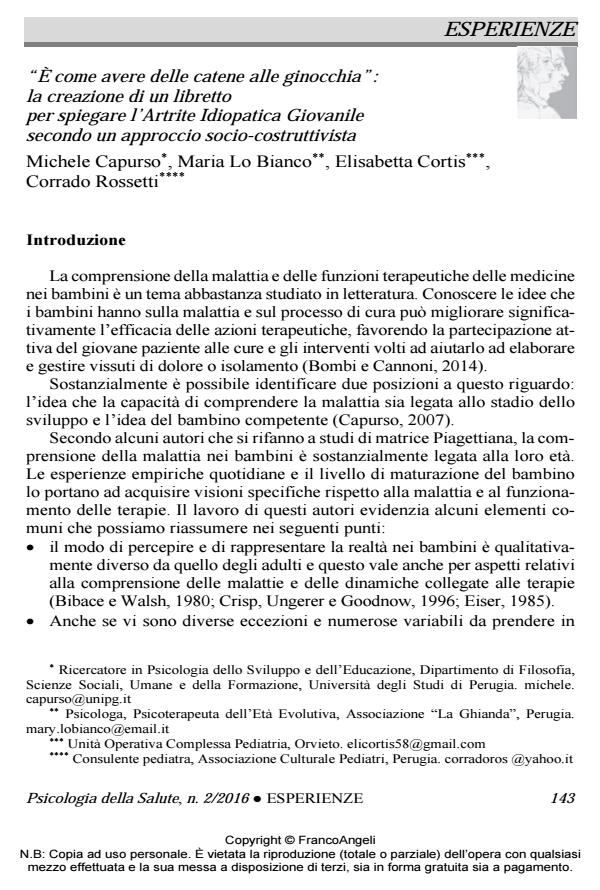"È come avere delle catene alle ginocchia": la creazione di un libretto per spiegare l’Artrite Idiopatica Giovanile secondo un approccio socio-costruttivista
Titolo Rivista PSICOLOGIA DELLA SALUTE
Autori/Curatori Michele Capurso, Maria Lo Bianco, Elisabetta Cortis, Corrado Rossetti
Anno di pubblicazione 2016 Fascicolo 2016/2
Lingua Italiano Numero pagine 18 P. 143-160 Dimensione file 392 KB
DOI 10.3280/PDS2016-002008
Il DOI è il codice a barre della proprietà intellettuale: per saperne di più
clicca qui
Qui sotto puoi vedere in anteprima la prima pagina di questo articolo.
Se questo articolo ti interessa, lo puoi acquistare (e scaricare in formato pdf) seguendo le facili indicazioni per acquistare il download credit. Acquista Download Credits per scaricare questo Articolo in formato PDF

FrancoAngeli è membro della Publishers International Linking Association, Inc (PILA)associazione indipendente e non profit per facilitare (attraverso i servizi tecnologici implementati da CrossRef.org) l’accesso degli studiosi ai contenuti digitali nelle pubblicazioni professionali e scientifiche
Questo articolo presenta una metodologia socio-costruttivista usata nella realizzazione di un libretto destinato a bambini e ragazzi con Artrite Idiopatica Giovanile, da usare come mediatore della relazione medico paziente al momento della comunicazione della diagnosi e durante il successivo processo di cura. Tale metodologia ha coinvolto attivamente alcuni bambini e ragazzi con questa patologia e si è svolta attraverso fasi diverse che hanno compreso: (1) la creazione di un libretto operativo basato su fumetti; (2) lo svolgimento di un laboratorio didattico-creativo con bambini malati e già consapevoli della diagnosi; (3) la raccolta e l’organizzazione delle narrazioni prodotte dai bambini in un libretto finale; (4) La revisione di quanto prodotto dai bambini da parte di genitori e personale sanitario. Ciascuna fase di lavoro ha contribuito alla costruzione del libretto finale. L’approccio socio-costruttivista adottato e il clima accogliente creato durante il workshop hanno facilitato i partecipanti nell’espressione dei loro vissuti e nell’ascolto dei loro coetanei. Il personale pediatrico consultato ha fornito indicazioni scientifiche per far sì che i contenuti trasmessi fossero corretti e aggiornati dal punto di vista medico-terapeutico. Il presente progetto dimostra come sia possibile fornire informazioni scritte che riguardano la malattia e la sua gestione terapeutica a bambini con AIG. Le narrazioni di altri bambini affetti da questa patologia hanno fornito informazioni che altrimenti sarebbero probabilmente rimaste trascurate da adulti e personale sanitario. La metodologia presentata in questo lavoro può essere testata e verificata in futuro con pazienti affetti da altre patologie per valutarne l’efficacia e l’estendibilità.
Parole chiave:Bambini, spiegazione della malattia, pensiero narrativo, socio-costruttivismo, Artrite Idiopatica giovanile, laboratorio
Michele Capurso, Maria Lo Bianco, Elisabetta Cortis, Corrado Rossetti, "È come avere delle catene alle ginocchia": la creazione di un libretto per spiegare l’Artrite Idiopatica Giovanile secondo un approccio socio-costruttivista in "PSICOLOGIA DELLA SALUTE" 2/2016, pp 143-160, DOI: 10.3280/PDS2016-002008